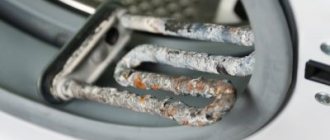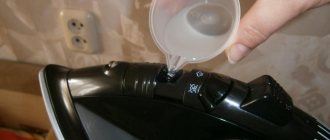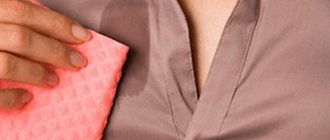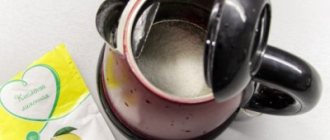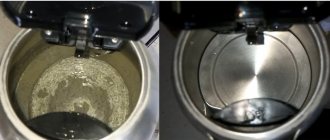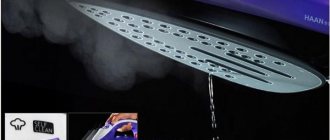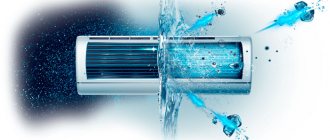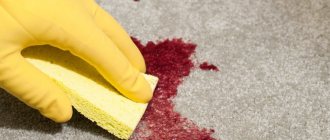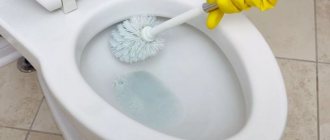No matter how modern an iron is, it is still necessary to descale it from time to time. You can quickly return the iron to its presentation form using improvised and special tools. Next, we’ll take a closer look at how to clean a Tefal iron from scale yourself at home.
General cleaning features
The soleplate of the iron requires cleaning periodically, even if you do not notice any visible defects. Often a subtle coating appears on the sole, which is clearly visible on light-colored clothing. Since steam irons use water to create it, sediment in it inevitably leads to scale.
Scale is dangerous because it clogs the water supply channels; steam is not produced in abundance and does not help ironing. Most often this is due to the fact that housewives use tap water, which is strictly prohibited. All manufacturers ask customers to use only distilled water.
Even then, cleaning is required from time to time, not to mention regular work with the steam chamber if unsuitable water is used. If we talk about the self-cleaning function, then in modern irons it is presented in the form of a rod, on the walls of which salt deposits and microelements accumulate. This helps to clean the iron at home in a simpler manner, but it will not save one hundred percent if used incorrectly.
If we talk about cleaning the surface, then in most cases special cleaning pencils are recommended. They are universal, so you can work with them for:
- Teflon;
- ceramics;
- stainless steel
Cleaning with a pencil involves preheating the iron. It is enough to move it along the surface of the sole. It is important not to forget about the safety rules described in the instructions for it. In addition to directly cleaning the burnt marks from the outer surface of the iron, it is important to work with the inner chamber.
Extreme cleaning of the iron - on a water “cushion”
When the condition of the sole of the iron is so bad that the pencil does not work as it should, a special “bath” is prepared for the device. For this:
- select shallow and wide dishes;
- install the device into it on a bridge made of wooden slats;
- pour in preheated water containing vinegar, citric acid and other cleaners;
- make sure that the water covers the steam holes, but does not touch the body;
- Leave the iron in this position for several hours.
In special cases, the container with the iron is additionally heated on the stove.
Self-cleaning function
This feature is provided to protect the device from scale formation. The iron's self-cleaning function also helps protect the fabric from the formation of stains and streaks during the ironing process. Its main goal is to eliminate traces of limescale on the internal surfaces of the main elements.
To get the desired result, this function should be used regularly. In this case, you need to partially disassemble and clean the iron. Among others, this feature is provided in Tefal brand devices. To take into account all the subtleties of the process, you must first study the instructions. You can clean the Tefal iron from scale and similar models with a self-cleaning function by following the recommendations:
- the water container will be filled to the top;
- turn on the iron, and you need to set the maximum power mode;
- when the signal light goes out, the device is turned off;
- take out an anti-lime rod over the sink;
- In order for the scale to be better separated, and steam with scale to escape through the holes more intensively, you need to shake the iron;
- the anti-lime rod is installed in place;
- the iron is placed on the heel;
- The device must be turned on to dry, but the hissing will continue.
As a result, automatic descaling of the container is started. The mechanism for implementing the function is based on the elimination of particles of the scale layer, which is destroyed during heating, through holes on the perforated sole of the iron.
Safety precautions when working with the self-cleaning function
After completing the cleaning procedure, it is recommended to rinse the container with water. This will remove any remaining scale from the iron that was destroyed during the self-cleaning process. At the same time, it is necessary to clean the base of the device. If this is not done, dirt will appear on the fabric during ironing. When performing these procedures, you must be careful, because the iron is hot and you can get burned.
Operation after self-cleaning
Even after cleaning the inside of the water tank and the outside of the soleplate, scale particles may remain. It is recommended to carry out a test ironing. However, one caveat needs to be taken into account. So, as a result of the manipulations described above, the sole becomes hot to the maximum temperature, and you cannot use the iron right away. This may damage the protective cover of the ironing board, and melted synthetic fabric will remain on the sole.
Chemical descaling agents
This method is most often used when the options listed above did not provide the desired result. If the contamination is complex, it is recommended to immediately select a special chemical agent.
Pencil
Before ironing, you need to clean the holes on the soleplate from scale particles. A special pencil is used for this. Fill the water tank and turn on the iron. As it heats up, you need to rub the sole with a pencil. Then the unnecessary piece of woven material is prepared. It is ironed by setting the steam setting on the iron. By pressing the hot air supply button, scale particles are removed along with steam.
Antiscale or analogue
This method is based on the use of acid, which corrodes the scale. It is necessary to dilute the powder with water, following the recommendations of the manufacturer of this product. The steam mode is not used. It is enough to pour Antiscale into the tank, leave the product for half an hour, having previously set the desired temperature on the iron. Then you need to pour out the substance and rinse the surfaces with water.
Topperr (Topper)
This product must be diluted with water in accordance with the manufacturer's instructions (1:2). First, heat the iron to maximum temperature. Then the prepared solution is poured into the tank. The iron is left in this state for 2 hours, then the substance is drained. The container is cleaned with water. It is necessary to fill the reservoir with liquid and switch the iron to steam mode. In this case, the liquid will evaporate along with the remaining scale.
Other
Other means are also used:
- Top House. The substance must be diluted with water. The recommended ratio for cleaning the steam generator and iron with steam function is 1:2. There should be 2 times more water than the chemical substance. The solution is poured into a container and the appliance is heated. Then it is placed on the sole, after which it is switched to steam mode.
- Cillit. The product must not be poured into a water tank. It is used to clean internal surfaces through holes in the sole. The product is poured using a pipette or syringe. After 10 minutes, add water in the same way. It is important that no chemical remains inside. You need to check the quality of ironing on an unnecessary piece of fabric. When streaks stop forming on the material, you can iron the clothes.
If there is no self-cleaning function
Iron with steam generator.
In this case, the inside of the device is cleaned with any descaling agent. The sequence of actions is as follows:
- Pour the product into the steam chamber.
- Turn on the iron and set it to maximum temperature. Wait for automatic shutdown.
- Press the steam release button above the container until there is no solution left in the steam chamber.
- Unplug the iron and rinse thoroughly with water after cooling.
Cleaning the iron should not be done over a sink, because limescale deposits come out at high temperatures and are difficult to wash off later.
What safe chemicals can be used
Even the most modern technology requires care and over time loses its advantageous characteristics. Modern irons require careful treatment and special care products.
Despite the special non-stick coating, if used incorrectly, carbon deposits can form on the soleplate of the iron, and in order not to spoil things when ironing, you must begin cleaning immediately. Under no circumstances should you use abrasive substances so as not to permanently damage the device.
Pencil for cleaning soles. The most inexpensive and widespread remedy. Outwardly it resembles a tube of lipstick. It is better to remove carbon deposits in a ventilated area, since the smell from the pencil is unpleasant. It is necessary to place something under the iron, as the product begins to flow when heated. The cleaning itself is very simple: the heated sole is treated with a pencil. Residues are removed with a rag.
Caution - abrasives!
Experts categorically protest against cleaning the heating surface mechanically. However, the metal sole can be cleaned of carbon deposits using such means as:
Have you bought a good Tefal Ultragliss iron? Are you disappointed that even it forms carbon deposits and has scale inside? Even the most reliable equipment loses its advantageous characteristics over time. You can quickly return the iron to its presentation form using improvised and special tools. Next, we’ll take a closer look at how best to do this at home.
Main problems and ways to solve them
Of course, it is worth noting that during operation you should only pour distilled water into the iron. Then the cleansing process will have to be carried out much less frequently. But, in principle, the most important problem is the formation of scale inside, which leads to stains on the fabric during ironing or insufficient steam generation. Often you have to clean the soleplate, as well as the iron rod. This is much easier to do than it sounds, don't be alarmed. Therefore, let's take a step-by-step look at the iron itself and the options for cleaning it.
To remove the rod, which serves as a protection against water lime, you need to take the iron off and pour out all the water from the reservoir. Then, opening the water container, press the inner button, usually white, and lightly pull the pin towards you. After this, put it for three hours in a container with water and vinegar or a sachet of citric acid diluted in it. This will complete task number one.
Preventing iron contamination
It is easier to prevent a “disease” than to treat it later. When ironing, it is important to follow the recommended temperature conditions for a particular type of material. Avoid touching the hot sole to accessories attached to clothing. To minimize the risk of scale formation, you need to use special purified or distilled water.
Iron manufacturers convince us that their models do not require additional care. However, in some cases, even a Teflon coating does not save the surface of the device. After contact with fasteners or metal elements, scratches may occur on the sole, which subsequently leads to the appearance of soot.
Therefore, for many people it is important to know how to quickly clean a Teflon-coated iron from traces of burnt fabric. For convenience, we have compiled a list of effective cleansing methods that are available at home.
How to clean ceramics?
To remove carbon deposits from a burnt ceramic surface, you can use all the means that are recommended for cleaning the Teflon layer. The heating surface of Tefal irons is best cleaned using a special sponge for non-stick surfaces and liquid detergents. In addition, specialized cleaning products for glass ceramics, which are sold along with special scrapers, will help to clean the base with such a coating from carbon deposits. Such well-known remedies as:
- soda, in the form of a solution or gruel, which is applied to a cold surface, then washed and wiped dry;
- laundry soap, which is applied for half an hour, then wiped dry;
- lemon juice or citric acid.
The ideal foundation - what is it?
When purchasing an iron, you should choose a soleplate with a large area and a comfortable shape. The most ergonomic are Tefal irons with a rounded back and a sharp nose. The number of steam holes (the more, the better) and their location (preferably on the spout) are also of great importance. The material from which the base is made can be metal (aluminum or stainless steel) or ceramic . Combined coatings are also very common, and each of them has its own advantages and disadvantages.
- Aluminum is a lightweight and inexpensive metal that is used in budget models, for example, Moulinex, Roventa, Philips, etc. Pure aluminum is soft and easily scratched, so a protective layer is applied to the aluminum base. Irons with Teflon coating, which has a non-stick effect and provides easy gliding, are widely used. Ceramic and other types of coatings are also used.
- Stainless steel heats up and cools down relatively slowly, is quite heavy, but very durable. Irons of various brands use a sole coated with chrome (Moulinex), sapphire (Brown), and ceramic enamel (Siemens). The most durable and expensive is a steel base with titanium coating (Panasonic, Roventa).
- Ceramics (cermets) are essentially a ceramic layer applied to metal. The heating time of such an iron may vary, but it retains heat for a long time, moves easily over any fabric and cleans quickly. However, ceramics is a very fragile material, and if chips and scratches form, getting rid of carbon deposits will be quite problematic, although a special coating, for example Ultragliss/Supergliss Actif from Tefal, is considered particularly durable.
How to clean an iron
There are many budget-friendly ways to remove scale and carbon deposits. There is no need to contact workshops for this. You will be able to neutralize the problem without much expense on your own. Both household chemicals and those products that are always on hand are suitable.
Inside from scale
The easiest way to clean the inside of a Tefal iron is to use the self-cleaning button. It is worth reading the instructions before starting the procedure; different models perform cleaning differently. It is permissible to add a solution of water with citric acid to the tank.
Household products
The most convenient way to clean a Tefal iron from scale and carbon deposits is a special pencil. It is sold in household chemical stores or electronics supermarkets. It's inexpensive. The bar resembles lipstick, and there are instructions on the packaging.
It is better to carry out the cleaning procedure on the balcony, in the yard, in a well-ventilated area, as an unpleasant odor may occur. To avoid discomfort, you can buy a pencil containing aromatic additives. Cleaning is done as follows:
- The device heats up to maximum temperature.
- The steam function is disabled.
- The sole is processed with a pencil.
- Remove any remaining product with a cloth.
To clean the holes, you need to release steam from the iron. After cleaning, you need to iron the unnecessary fabric to ensure that all pencil residue is removed.
Industrial
If the available means that you always have in the house are not very effective, you can resort to “heavy artillery.” Specialized gels, solutions and powders of industrial production are presented in an assortment. When using them, it is better to wear protective gloves to avoid direct contact with skin.
Iron performance characteristics
Supply voltage: 220-240 V, 50-60 Hz; Power consumption: 2350-2800 W;
Water tank volume: 300 ml;
Power cable length: 1.9 m.
Dimensions (LxWxH): 310x125x150
Weight: 1.5 kg
Sole material: Durilium Air Glide (enamel-ceramic).
More detailed technical specifications are available on the official website.
When setting the thermostat indicator opposite the ironing conditions symbols, the temperature in the center of the iron sole must correspond to the generally accepted heating temperature for these symbols.
To test this, the minimum and maximum temperatures were measured for each position of the thermostat temperature indicator. Measurements were taken over five consecutive on-off cycles of the thermostat. Then the arithmetic mean of the five minimum and five maximum temperatures was calculated.
Temperature measurements were carried out in the center of the iron sole using a Mastech M266C multimeter and an LT-300 electronic laboratory thermometer. The measurement results are shown in the table.
To measure the heating time of the iron sole, the thermostat indicator was set to the maximum position. Heating duration was defined as the time required for the center of the soleplate of the iron to reach its maximum operating temperature. The measured heating time was 50 s.
The water sprayer should provide moisture to the fabric by splashing onto the ironing area.
The iron was placed on the fabric, after which the water spray mechanism button was pressed three times. Then measurements were taken of the described rectangle around the moistened area.
As a result of the test, the boundary of the area moistened by spraying water, farthest from the iron, is located at a distance of 300 mm from the front of the iron sole. The center of the described rectangle around the moistening area is located on the line of the given spray direction. The deviation of the moistened area from the longitudinal axis of the iron sole is up to 40 mm.
at the hottest point of the sole; in the center of the sole; at points located on the longitudinal and transverse axis of the sole at a distance of 20 mm from the edges.
Specialty purchased chemicals
Preparations used to clean irons allow you to quickly, efficiently and carefully remove scale from the internal and external parts of the device without damaging the non-metallic elements of the device.
"Antinakipin" or analogue
Antiscale is considered the most popular commercial anti-scale product. It will easily dissolve mineral deposits, after which removing them will not be difficult. The product is diluted with clean water, following the instructions, after which the solution is poured into the tank. Next, the device needs to be heated to maximum, unplugged and left for half an hour.
The amount of cleaning solution depends on the volume of the tank. Then the device is strongly heated again, and after cooling, all the liquid is removed along with pieces of plaque. Next, the container must be rinsed under running water, dried and replaced. After the procedure, be sure to test iron the unnecessary piece of fabric.
Top house
Use the German drug according to the following scheme:
- mix 50 ml of product and 100 ml of water;
- pour the solution into the iron and place the device in a vertical position;
- turn on the device, after heating, disconnect it from the network;
- place the iron horizontally for 10 minutes (on a special stand or table, after placing slats or pencils under the hot sole);
- After the specified time has passed, place the device over a sink, bathtub or basin and, shaking the equipment, release steam.
Usage
To ensure fire safety, the TEFAL Turbo Pro Anti-Calc FV564 iron has an auto shut-off function. It turns off the heating if the iron is stationary in a horizontal position for 30 seconds or in a vertical position for 8 minutes.
The ''drip-stop'' function is used to prevent water from leaking from the holes in the soleplate of the iron.
Automatic adjustment of steam supply implies a change in the amount of steam release depending on the heating temperature of the iron sole set by the thermostat indicator.
While ironing at maximum temperature, a small amount of water leakage was noticed. At a lower ironing temperature, no water leakage occurred.
When dry ironing, there was no water leakage.
The iron can be used for vertical steaming of items. To do this, you need to turn off the automatic steam supply by moving the steam supply regulator to the right position, and set the thermostat indicator to the maximum position. Steam will be supplied in a vertical position by pressing the trigger located under the handle. When using automatic steam, a small amount of water may leak during vertical steaming.
Self-cleaning function
The self-cleaning function is designed to wash the steam chamber and steam supply holes from various scale deposits formed during the operation of the iron.
To do this, you need to fill the water tank to the maximum level, set the thermostat indicator to the maximum position, and set the steam control to dry ironing mode and turn on the iron. After heating the iron, you need to unplug it, hold it in a horizontal position over the bathtub or sink for a while, and then remove the anti-scale valve. After the water exits through the steam holes, it is necessary to install the anti-scale valve in place.
The manufacturer claims a steam boost of up to 210 g/min. Unfortunately, there is no way to quantify this indicator. Having used this function in practice, I can conclude that this statement is close to the truth. Thick and voluminous steam emanates from all openings.
Five items were taken as ironing samples:
- linen scarf;
- shirt containing 80% viscose and 20% cotton;
- cotton shirt;
- robe containing 60% cotton and 40% polyester.
As a result, TEFAL FV564 successfully completed its task. The linen scarf was the most difficult to iron.
Automatic steam supply allows you to smooth out the most difficult wrinkles. Ironing the fabric near the buttons was also no problem.
We suggest you read How to clean the joints between tiles: the most effective methods
You can see the ironing results below.
Almost throughout the entire territory of Russia there is increased water hardness. In addition, tap water is saturated with sodium and fluoride. Using such water to fill the iron's container increases scale and limestone deposits inside the appliance.
Therefore, the self-cleaning function should be performed as often as possible. Irregular or occasional cleaning leads to the formation of a dense layer of scale on the internal parts of the appliance sole. Then the self clean function on the iron becomes useless.
Simple folk remedies against scale
Inexpensive or older Tefal models may not contain a self-cleaning system. If you have just such a device, you don’t need to worry about this, because you can clean your iron from scale using proven folk methods.
Lemon acid
One of the effective remedies is citric acid, which is found in almost every home. It allows you to quickly get rid of scale without damaging the internal equipment of the device.
When cleaning with citric acid, use the steam button
Cleaning with lemon powder is similar to self-cleaning. Take a glass of water (20 ml) and dissolve 25 g of product (1 sachet) in it. Pour the resulting solution into the tank and connect the iron to the network. After heating, activate the “Steam boost” function. As a result, the acid will react chemically with the plaque and dissolve it, cleaning the holes from the inside. Finally, repeat the procedure with clean water to remove any remaining citric acid. After cleaning, be sure to perform a test ironing to ensure the device is clean.
Mineral water
Mineral water, which has a rich composition, has proven itself to be excellent in the fight against salt deposits on heating parts of equipment. Pour the liquid into the iron container and heat the equipment to +140 ℃. Hold the device over the basin and turn on the steam mode. Complete the procedure by cleaning with distilled water.
Actions using vinegar
The most labor-intensive process is considered to be boiling with vinegar, but the effect remains amazing and there is no chance for scale to linger in the iron. To do this, you will need a heat-resistant container, wooden sticks or spoons, water and vinegar. It is important that the iron is unplugged from the mains at all times!
Follow the following instructions:
- 1 For 1 liter of water, 200 ml of 9% table vinegar, combine the ingredients and bring them to a boil.
- 2In a separate container, place wooden sticks parallel to each other and place the iron on them with the ironing surface down.
- 3Fill the household appliance with a hot water-vinegar solution so that the sole comes into contact with the water and the remaining plastic parts do not touch the liquid.
- 4Then place the container on the gas surface and boil the iron in this way for 10-15 minutes. This time is more than enough for the scale to come out.
- 5Rinse the water tank separately under running water if there are traces of salts on it.
- 6After the iron has cooled down, wipe its surface and do not turn it on for the next 24 hours.
Laundry soap
- chop 1/3 of the bar on a fine grater;
- turn on the iron, set the maximum temperature;
- after turning off the device, apply soap to the entire surface of the sole;
- when the iron has completely cooled down, remove the melted shavings along with particles of dirt using a damp sponge;
- Wipe the device with a damp cloth and dry it.
Using toiletries
Liquid toilet soap and shower gel are also mild cleaning agents for the Teflon coating of the ironing part of a household appliance:
- heat the iron slightly, unplug it;
- apply a little liquid detergent to the sponge and treat the sole of the device with it;
- After 40 minutes, wipe the surface several times with a cloth dampened in clean water, then dry with a soft towel or cloth.
Appearance
The iron has a form factor familiar to this type of device. The case is plastic, black and white. The water container is made of translucent plastic. It is not difficult to control the water filling level.
On the sides of the device, on white inserts, there are pictograms reflecting its functionality. Tefal is also trying to draw the consumer’s attention to the fact that this iron model is produced in France.
In the front part of the iron there is a spray nozzle, a neck for filling water, a steam mode switch and a spray button.
I would like to dwell in more detail on the water fill neck; the TEFAL FV5645 has a really large one, its diameter is 27 mm. Thanks to this, you don’t have to worry about the lack of a measuring cup in the package; it’s convenient to draw water directly from the tap.
On many irons, when drawing water, you have to hold the neck cover so that it does not get in the way. The manufacturer took care of this and equipped the lid with a spring. The lid closes tightly and prevents water leakage when using the iron.
TEFAL Turbo Pro Anti-Calc FV5645 is equipped with an anti-scale valve, which is combined with a steam mode switch. Recommendations for cleaning it are described in the instruction manual, as well as in a short video from Tefal.
We suggest you read: How to clean urine from a mattress
The temperature regulator and steam trigger are located under the handle of the iron.
The temperature is selected using a multi-position rotary thermostat. It has captions in English and German, as well as intuitive icons for heating temperature and the ability to use steam when ironing.
The iron informs the user about its condition with a red indicator, which is located near the cable entry. A constant glow of the indicator indicates that the sole is heating up. After heating it turns off. When the auto shutdown mode is activated, the indicator begins to “pulsate”.
In a vertical position, the iron is very stable thanks to its wide stand. The plastic cable gland freely changes its position in only one axis. The fitting is made of soft polyurethane. The power cable is fabric braided, its length is 1.9 m. The plug is cast, hybrid type CEE 7/7.
The manufacturer claims that the product can be repaired for 10 years. I believe this means providing official service centers with spare parts for this model. If you are not used to going to a service center, then you will need a Torx T20 screwdriver.
During operation, especially if you use hard water, scale formation is inevitable. Its accumulation leads to a reduction in the power of steam generation, the formation of stains on clothes, clogging of holes in the soleplate of the iron, and also deterioration of sliding. To extend its service life, TEFAL has equipped the Turbo Pro Anti-Calc FV5645 iron with a scale collector. Scale collection is carried out due to the special internal design of the iron.
To clean the anti-scale collector, you need to bend the orange petal and turn it counterclockwise - this will allow you to remove it from the iron for washing.
The sole of the Durilium Air Glide iron is a metal-ceramic base with an enamel coating. Its thickness is 3 mm.
Under the soleplate of the iron there is a marking with technical information about the iron.
To conclude this section, I would like to note that some parts of the case do not fit well, and the stand, at its base, has a slight play.
Cleaning soles at home: which traditional methods work
Cleaning the soleplate of a modern iron from scale simply uses folk remedies.
Option one - salt and paraffin. Place a thin layer of table salt mixed with paraffin on a sheet of paper (grate the candle). The device is heated and driven over a salt-paraffin layer. Usually, plaque, burnt marks and dirt easily come off the surface after such treatment. After cleaning, wipe the soleplate of the iron with a clean, damp cloth.
If there is slight scale build-up, you can try cleaning the soleplate of the iron with a cotton pad soaked in vinegar. To enhance the effect, ammonia is added to vinegar. Cleaning is also carried out by ironing a cloth soaked in a vinegar-ammonia solution.
A proven way to clean an iron is hydroperite tablets. Here you need to take into account the specific smell that accompanies the procedure and carry out cleaning in a well-ventilated area. The processing principle is simple: the iron is heated, a tablet is passed over its surface, similar to cleaning with a pencil. The final stage is cleaning with a dry cloth to remove remaining scale and dirt.
You can try to clean the steam holes on the soleplate that are clogged with scale using hydrogen peroxide and a cotton swab or regular acetone.
In conclusion, it remains to be noted that when using traditional methods for processing the soleplate of an iron, you should under no circumstances use sharp objects, for example, a knife, sandpaper, nail file, etc. Products containing abrasive particles are also at risk.
Methods for cleaning Teflon surfaces
The most difficult thing to clean is Teflon sole, which quickly loses its quality if not properly cared for. In order to effectively and safely clean such an iron at home, you can use the following methods:
- A special pencil or other branded products for softening carbon deposits, which are applied to a heated base, and after cooling, wiped with a soft, dry cloth. The components of the pencil are harmless, although they have a pungent odor. It can be a big nuisance if these products get into the steam holes, so they should also be cleaned with a cotton swab dipped in vinegar.
- If you don't have a pencil, you can clean the heated coating with paraffin or wax (after wrapping it in cloth).
- A hot iron can be cleaned with hydroperite or hydrogen peroxide.
- A good solution for removing carbon deposits is regular vinegar. They moisten a napkin made of coarse fabric with it, which is ironed with an iron (with a Teflon base - only cold).
- After more or less prolonged use, the base of the iron should be washed with any dish soap and wiped dry.
How to care for irons to avoid scale build-up
To ensure that the iron does not break down longer or spoil the laundry when ironing, you must follow the instructions for using the device. A few simple rules will help save your home assistant:
- Use purified water. You can replace it with boiled water or a special one with fragrance, which is sold in stores. This will help prevent scale formation.
- Do not fill water above the maximum mark
- Following the ironing and steaming regime will help preserve things and extend the life of the iron.
- At the end of using the device, drain the water from the steamer.
- For preventive purposes, it is necessary to descale the appliance at least once a month.
Any household appliance requires care and compliance with operating rules. It is necessary to pay attention to what materials the device is made of before cleaning the iron from scale inside at home. Not every method that was effective 10 years ago is suitable for modern Tefal models.
Careful care and timely cleaning will allow your home assistant to serve for a long time.
Video material
To extend the life of your faithful assistant - the iron, follow only 3 rules: first - carefully read the instructions supplied with the device, second - take all preventive measures to prevent scale both outside and inside, third - regularly clean the device from salts and minerals. sediments. And when working on caring for your equipment, use the tools and methods that we have selected for you in the article.
Adviсe
To prevent scale from forming in the Tefal steam generator, you must adhere to the following recommendations:
- fill the tank only with distilled or filtered water;
- For each work session, fill in a fresh portion of water;
- do not use flavored or mineral water to steam clothes;
- Clean the soleplate of your iron regularly.
Even the purest water releases salts when heated. Therefore, every steam generator requires cleaning from time to time.
During active use of the device, it is recommended to carry out this procedure 1-2 times a month.
Is it possible to restore Teflon coating?
With prolonged use of the Teflon coating, over time it wears out and scratches appear on the surface. The coating begins to lose its non-stick qualities, adhesion increases.
To extend its functionality, you can try the following recovery method:
- grate a small piece of paraffin candle, mix it with fine salt;
- spread the mixture in a thin layer on the fabric;
- put a paper napkin or thin cloth on top;
- then iron it with a heated iron several times;
- Finally, clean the sole with a cloth.
As a result, the problem area should become smooth, and the scratches should be almost invisible. If this method does not give the desired effect, then the coating is completely damaged.
In order not to buy a new device, you can replace the non-stick layer by restoring the Teflon coating of the iron. For this purpose, the corresponding service companies use special restoration technology.
When re-coated with Teflon, the original properties of the surface will be noticeably restored.
